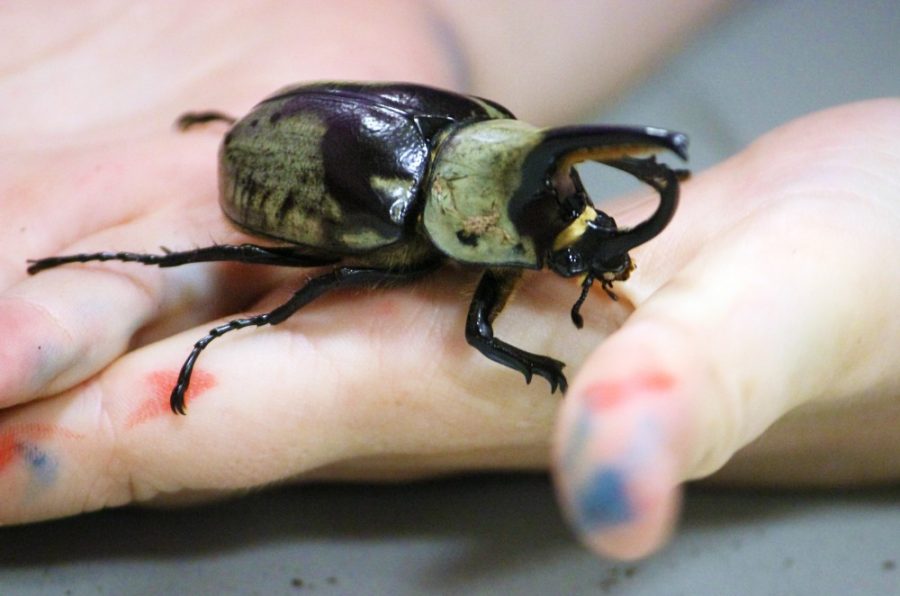The 2016 Arizona Insect Festival allowed patrons to meet, greet and even eat some of Arizona’s native insect species this past Sunday in the Student Union Memorial Center Grand Ballroom.
Hosted by the Department of Entomology, the festival featured not only UA scientists, but as well as many community groups including the National Park Service and the Southeast Arizona Butterfly Association.
This year, participants had the opportunity to sample mealworm-and-onion nachos, hold a hissing cockroach or a more docile caterpillar and learn all about the wide variety of insects that share Tucson’s desert ecosystem.
UA graduate student Angela Hoover has been volunteering at the festival for three years and said the interactive booths are a huge draw.
“Everyone wants to come and see and touch,” Hoover said.
While the booth Hoover volunteered at this year didn’t allow any handling of the insects—that particular booth’s bombardier beetles mix foul-smelling chemicals in their abdomens to shoot when startled—she said kids were definitely still interested, mostly because of the smell.
John Palting, an entomology PhD. candidate, agreed that kids tended to like anything they could touch or anything too gross to touch, as he handed out caterpillars and explained the difference between incomplete and complete metamorphosis to a group of eager children.
Pointing out a large, glass tank of dung beetles, Palting said that he just “threw those in” as an extra draw, since he really focuses on caterpillars.
RELATED: The king of sting Justin Schmidt gets stung for science
“The kids usually love it, and the parents are usually a little freaked out,” Palting said. “I like to try to get stuff out in the open—not in cages—and in people’s faces.”
Palting said that the festival tries to “highlight the organisms that people are actively working with,” and make people “familiar with what’s in their backyards.”
Each year, the festival spotlights one native species for that reason. This year it was the Western Hercules Beetle, an insect that Hoover described as “the cow of the insect world” due to its size.
A type of rhinoceros beetle, Western Hercules Beetles can grow to three inches long and—true to their name—the males sport horns. The large, shiny beetles were passed from hand to hand at their booth, with some children getting on eye level with the insect and others shying away.
Brother and sister Zarek and Zaida Phelps represented both ends of that spectrum. Zarek let the beetle walk across his palm, glancing to his mother, Kayla Phelps, every so often for reassurance. Zaida, on the other hand, refused to let the “gross” star-of-the-show anywhere near her.
“I like holding the bugs and touching the bugs,” Zarek said.
He called the cricket cookie he tried “good” as well, while Zaida made a face in disgust.
No matter the reaction, the overall engagement is what matters, according to Palting.
“[Insects] are everywhere, available to everyone,” Palting said. “This is a good way to get kids into science.”
Girl Scout Troop 122 was doing just that as they toured the booths. While some troop members cupped cockroaches in their hands, petting them to make them hiss, others used a less hands-on approach to learning.
RELATED: Love is a fruitless venture: Courtship dances of fruit flies and fertility
Mia Valdivia stuck close to her father, Erwin, and kept an eye on the cockroach a friend held as she talked about everything she had learned. She called the insects “interesting,” but in the end said she still didn’t like bugs.
Hoover said the festival has more subtle benefits for the entomology department as a whole as well. Since it’s mostly the graduate students who go out and collect all the insects in the week or so leading up to the festival, that creates a fun and social atmosphere after the stress of organizing everything.
“It really brings everyone together,” Hoover said. “Entomology can be a fragmented department at times because everyone has their specialty groups [of insects].”
Palting added that he spent about 60 hours collecting insects for the festival, but he too thinks it’s all worth it.
“It’s a challenge, but it’s fun and rewarding,” Palting said.
Follow Marissa Heffernan on Twitter.









